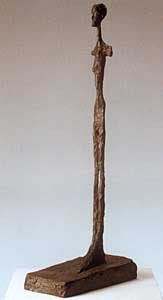Aberto Giacometti
The exhibition presents, for the first time in Spain, drawings made by Giacometti —the centenary of whose birth will shortly be commemorated— as copies of masterpieces from the History of Art, an activity that he practised throughout his life. In these drawings, obtained from collections and museums in Europe and for the most part not seen here before, Giacometti interprets works of art from antiquity —Sumerian, Egyptian, Greek, Byzantine or African— and works by Rembrandt and Van Eyck, and even by artists who were his contemporaries, such as Lipchitz, Matisse or Mondrian. These works provide a new view that makes it possible to reconstruct the various periods of his artistic creativity and that shows his activity as a “copyist” of masterpieces from the History of Art. They also provide a comparison of his work as a copyist with his own creative activity, represented by forty paintings and sculptures, including some of his outright masterpieces. The catalogue published to accompany the exhibition contains essays by Casimiro Di Crescenzo and Simone Soldini, who analyse Giacometti’s work in relation to his copies, together with an extensive bibliographical selection and illustrations reproducing the sculptures, paintings and drawings exhibited. Alberto Giacometti (Borgonovo, 1901 – Chur, Switzerland, 1966) is one of the most important and also most complex figures on the art scene in the twentieth century. Born into a family of artists, he showed a vocation for art at an early age, making his first sculpture, a bust of his brother Diego, at the age of thirteen, and his first paintings at an even earlier date. In 1919 he enrolled at the École des Beaux-Arts and the École des Arts et Métiers in Geneva, and during 1920-21 he visited museums in Italy and made his first copies of great painters such as Cimabue, Giotto and Tintoretto. Throughout his life Giacometti studied the work of numerous artists by interpreting their work in copies —of his favourites, such as Dürer and Rembrandt, and of others who range from Van Eyck to Fragonard and from Van Gogh to Cézanne, one of his constant references, not forgetting his contemporaries, Matisse, Picasso, Lipchitz, Braque, Derain, Mondrian and others. In 1922 he moved to Paris, where he worked with Archipenko and followed the work of Lipchitz and especially Henri Laurens very closely. He began to produce non-figurative objects, reduced to simple, essential, imaginary, symbolic forms, in some cases with erotic connotations, such as Le Couple (The Couple), 1926, La femme-cuillère (Spoon Woman), 1928, and Boule suspendue (Suspended Ball), 1930. In the objects of the early thirties relationships of opposition were established between antithetical forms or concepts: full/empty, curve/edge. In these works the Surrealists saw the sculptural materialisation of what appears in dreams and the imagination. André Breton mentioned L’Objet invisible (Invisible Object), 1934-35, in L’Amour fou. However, Giacometti moved away from the Surrealists, whose strongly hierarchical discipline he rejected. After his break-away from the Surrealists he experimented in the fields of sculpture and painting, and for twelve years he did not exhibit his work. His output from this second period is possibly the work that is best known to the public. In 1945 he resumed his questioning of the world around him and of nature. It was then that he made the greater part of his sculptural work and nearly all his paintings. He focused his exploration on portraits of only two or three people —his brother, his wife, and occasionally another model, such as his friend Eli Lotar. His fleshless figures became taller in an extreme stylisation which accentuated their fragility in relation to the space around them, as can be seen in the works exhibited, including Femme qui marche (Woman Walking), 1932-36 (Peggy Guggenheim Collection, Venice), Tête. Autoportrait (Head. Self-portrait), 1927, and Le Vide-poche (Receptacle), 1930 (Galerie Jeanne Bucher, Paris), Femme debout (haut chignon) (Woman Standing [High Chignon]), c. 1948, La Cage (première version) [The Cage (First Version]), 1950, Tête de cheval (Horse’s Head), 1950, a painting which he presented to his friend Miró, Diego au Chandail, (Diego in a Jersey), 1953, and Caroline, 1961. At the end of his life, having been hailed as one of the great sculptors of the twentieth century, Giacometti emphatically upheld his work as a painter. These paintings derive from the same tragic sense of existence, the same anguished search for reality, which Giacometti considered fruitless because of his own certainty that he would never succeed in capturing the true essence of being, despite his tireless activity and incessant scrutiny of his models and the reality around him.



